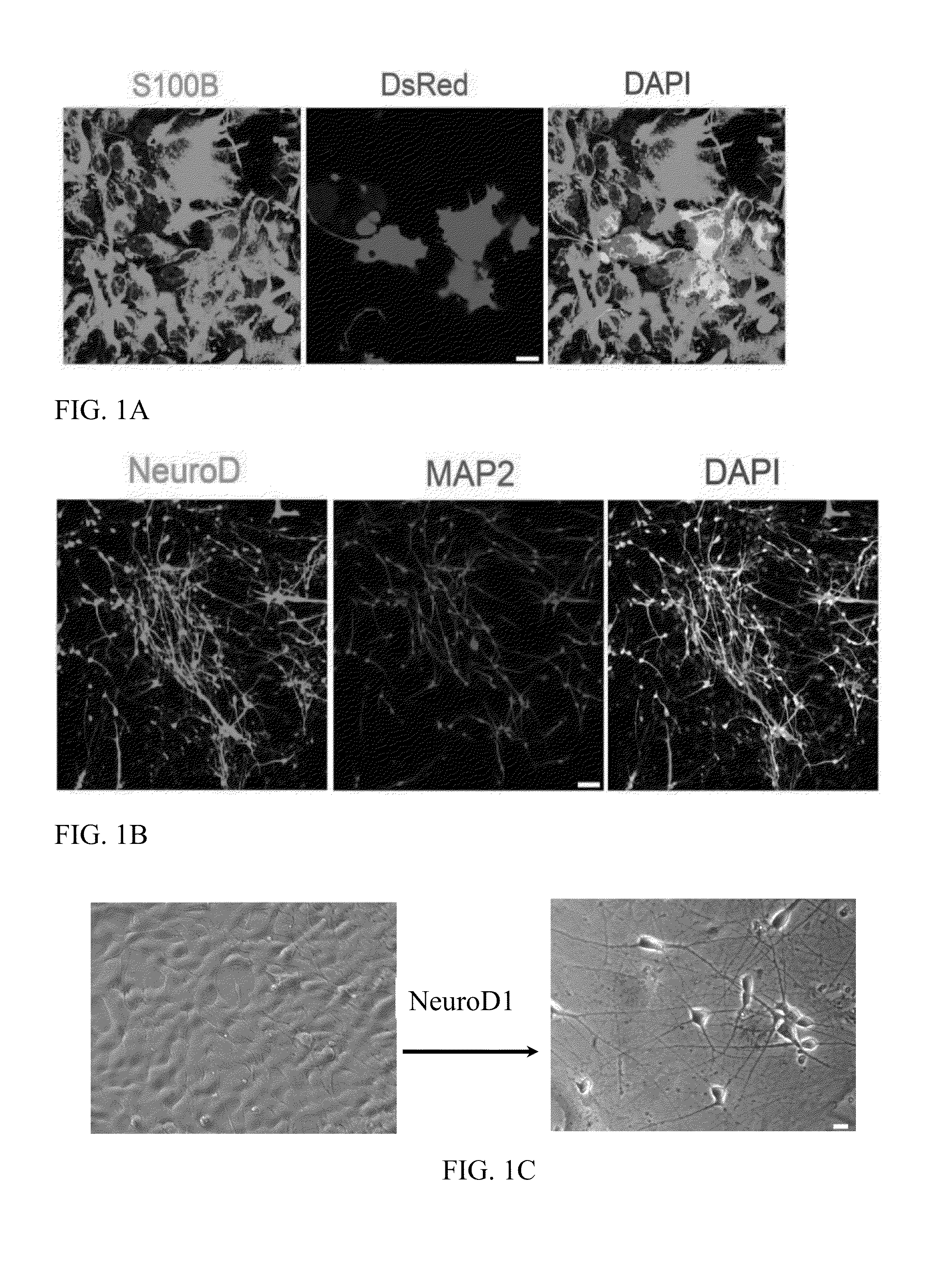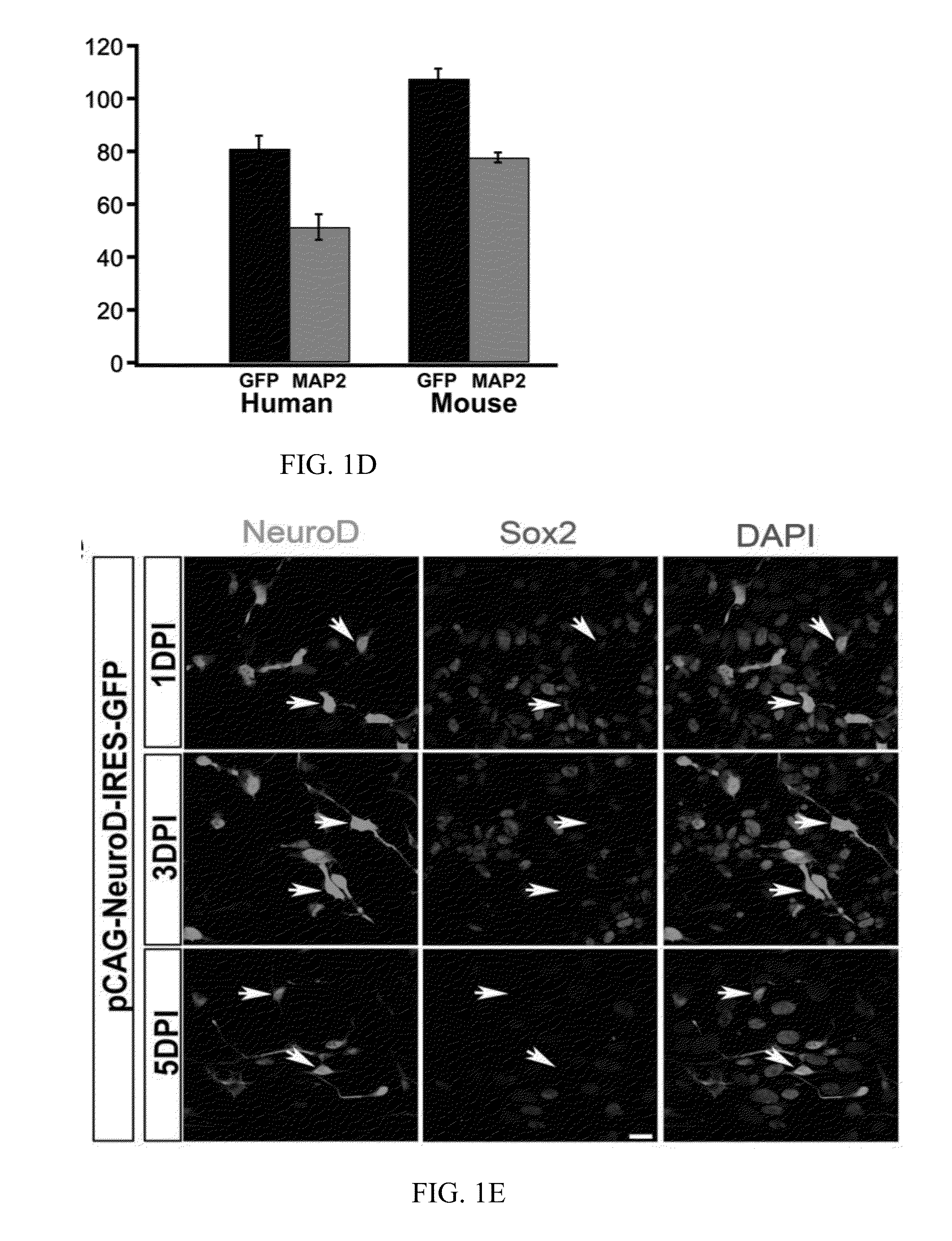Methods and compositions for treatment of disease or injury of the nervous system
a technology of the nervous system and composition, applied in the direction of drug composition, peptide/protein ingredient, metabolic disorder, etc., can solve the problem of no method available to reverse glial scars for brain repair
- Summary
- Abstract
- Description
- Claims
- Application Information
AI Technical Summary
Benefits of technology
Problems solved by technology
Method used
Image
Examples
example 1
Human Cortical Astrocytes
[0118]Human cortical astrocytes (HA1800) were purchased from ScienCell (California). Cells were subcultured when they were over 90% confluent. For subculture, cells were trypsinized by TrypLE™ Select (Invitrogen), centrifuged for 5 min at 1,000 rpm, re-suspended, and plated in a medium consisting of DMEM / F12 (Gibco), 10% fetal bovine serum (Gibco), penicillin / streptomycin (Gibco), 3.5 mM glucose (Sigma), and supplemented with B27 (Gibco), 10 ng / mL epidermal growth factor (EGF, Invitrogen), and 10 ng / mL fibroblast growth factor 2 (FGF2, Invitrogen). The astrocytes were cultured on poly-D-lysine (Sigma) coated coverslips (12 mm) at a density of 50,000 cells per coverslip in 24-well plates (BD Biosciences).
example 2
Retrovirus Production
[0119]The pCAG-IRES-DsRed plasmid (Heinrich, C. et al., Directing astroglia from the cerebral cortex into subtype specific functional neurons. PLoS Biol 8 (5), e1000373 (2010)) containing the DsRed fluorescent reporter gene was used as the test plasmid. The mouse NeuroD1 gene was subcloned from the pAd NeuroD-1-nGFP (Addgene) and inserted into a pCAG-GFP-IRES-GFP retroviral vector (Zhao, C., Teng, E. M., Summers, R. G., Jr., Ming, G. L., & Gage, F. H., Distinct morphological stages of dentate granule neuron maturation in the adult mouse hippocampus. J Neurosci 26 (1), 3-11 (2006)) to generate the pCAG-NeuroD1-IRES-GFP plasmid, encoding the NeuroD1 protein of SEQ ID NO: 4. The restriction enzymes BamH I and Age I were used for subcloning. Viral particles were packaged in gpg helperfree HEK (Human embryonic kidney) cells to generate VSV-G (vesicular stomatitis virus glycoprotein)-pseudotyped retroviruses encoding neurogenic factors. The titers of viral particles w...
example 3
Culture Conditions for Trans-Differentiation of Human Astrocytes into Neurons
[0120]Twenty-four hours after infection of human cortical astrocytes with retrovirus encoding DsRed or encoding NeuroD1, the culture medium was completely replaced by a differentiation medium including DMEM / F12 (Gibco), 0.5% FBS (Gibco), 3.5 mM glucose (Sigma), penicillin / streptomycin (Gibco), and N2 supplement (Gibco). Brain-Derived Neurotrophic Factor (BDNF, 20 ng / mL, Invitrogen) was added to the cultures every four days during the differentiation to promote synaptic maturation.
PUM
| Property | Measurement | Unit |
|---|---|---|
| flow rate | aaaaa | aaaaa |
| volume | aaaaa | aaaaa |
| speed | aaaaa | aaaaa |
Abstract
Description
Claims
Application Information
 Login to View More
Login to View More - R&D
- Intellectual Property
- Life Sciences
- Materials
- Tech Scout
- Unparalleled Data Quality
- Higher Quality Content
- 60% Fewer Hallucinations
Browse by: Latest US Patents, China's latest patents, Technical Efficacy Thesaurus, Application Domain, Technology Topic, Popular Technical Reports.
© 2025 PatSnap. All rights reserved.Legal|Privacy policy|Modern Slavery Act Transparency Statement|Sitemap|About US| Contact US: help@patsnap.com



